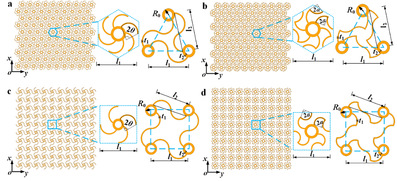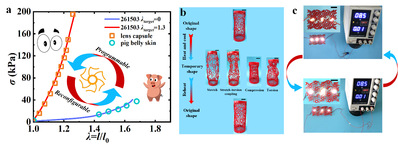Xiaozhou Xin, Liwu Liu, Yanju Liu, Jinsong Leng
Advanced Functional Materials, 2021.
DOI: 10.1002/adfm.202004226
Auxetic mechanical metamaterials, which expands transversally when axially stretched, have been widely used in flexible electronics and aerospace. However, the chiral metamaterials suffer from three severe limitations as a typical auxetic metamaterials: narrow strain range, non-tunable mechanical behaviors and fixed properties after fabrication.
The wavy ligament microstructures were introduced into the chiral metamaterials to solve the limitations of narrow strain range and non-tunable mechanical behaviors of conventional metamaterials. The microstructures of the developed chiral metamaterials were composed of wavy ligaments and a node, all of which had 180° rotational symmetry (Figure 1). The chiral metamaterial can be divided into hexa- and tetra-chiral metamaterials, depending on the number of ligaments surrounding each node. The six dimensionless geometric parameters of the microstructure, including ω/l1, l2/l1, R0/l1, t2/l1, t1/l1, and 2θ (2α), determined the macroscopic configuration and mechanical properties of the metamaterials. The effects of geometric topological parameters and deformation (λ) on the mechanical properties of metamaterials under infinitesimal and large deformation were investigated. The quantitative relationship between mechanical properties and λ enabled the programmability and reconfigurability of the metamaterial, breaking through the limitation that the properties of conventional chiral metamaterials cannot be changed once manufactured. The diversity of the microstructure provided tunable mechanical properties in a wider range, demonstrating a great degree of design freedom.

Figure 1 CAD models and geometric parameters of the auxetic metamaterials.
More interestingly, the nonlinear mechanical responses of the auxetic materials were able to match specific tissues/organs (i.e., pig belly skin, iliac artery, muscle fiber, and dog lung), and can transform between two biomaterials (Figure 2). In addition, LED integrated device demonstrated its potential application in flexible electronics. A negative Poisson's ratio shape memory biomedical scaffold with customized mechanical properties and configuration showed the possibility of the developed metamaterial expanding into 3D space (Figure 2).

Figure 2 (a) Comparison of σ-λ curves between metamaterials and tissues/organs (The data of tissues/organs from Macromolecules, 2019, 52(20), 7531–7546). The application of metamaterials in (b) biomedical scaffold and (c) LED integrated devices.